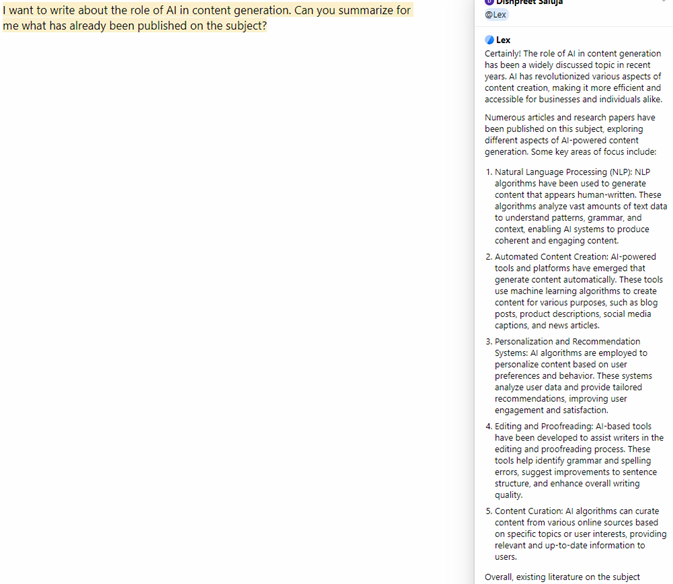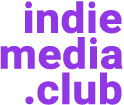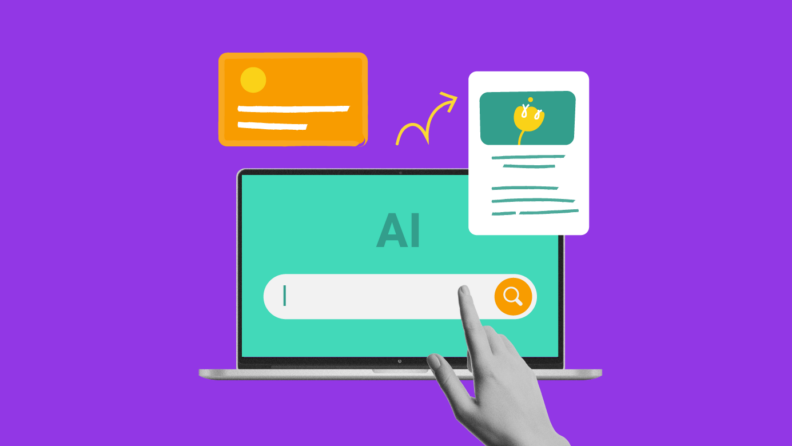As content creators, writers and editors working in the “creative” clockwork, we are often left feeling challenged and insecure at the mere mention of Artificial Intelligence. (Read: THE MACHINE-PEOPLE ARE COMING FOR US!)
However, we cannot be paranoid content creators forever at odds with AI content creation. Let’s stop looking at AI as the scary “other” and borrow some perspective to befriend it.
Remember the barebones definition of “democracy” we were taught in school? Well, that is how I now choose to look at AI when I am trying to understand it and be pals with this enigma—it is “of the people, for the people, and by the people”. Besides, it also does more for its people in real-time than the democracies we know of, as we will see through the course of this article. (Although I must mention, this was the last you read of politics here!)
What AI Does For Content Creators
It’s no lie that creating content can be tedious and monotonous, taking huge chunks of time off our day. Now add to this the work-from-home / independent worker’s context. Well, it is beginning to sound morose already!
Despite the passion and love we harness in the content we create, it comes with its own set of challenges.
- How do we come up with ideas for a new piece of content, day in and day out?
- What do we base the idea on or gauge its viability in the market?
- How do we always create unique content, given the rate at which content is being consumed?
- How do we tailor it for users to personalize the experience and make it accessible for all consumers?
- How do we ensure a piece of content would do well in the SEO-ruled void of the World Wide Web?
While Artificial Intelligence is not the all-in-one solution for all pitfalls we are faced with, as it absolutely should not be, it does make our lives easier. Let’s take a closer look at the challenges mentioned in greater detail.
1. Coming Up With And Building On New Ideas
As independent content creators, writers and publishers, we often need a sounding board to bounce off ideas or find the niche one can leverage. And, while nothing beats a team of writers/creators all huddled up to keep each other going until all mental blocks disappear into inspiration and, finally, a stellar piece of content, as an independent creator you might find the perfect sounding board in a Chat Bot!
Especially for creators who are only starting out, even a free, open Chat Bot like ChatGPT 3.5 by OpenAI is excellent for generating ideas one would want to work on or create content about. Often, zeroing in on an idea would require us to do thorough market research to find the kind of content that would promise engagement and land on the Target Audience’s screen. However, now with AI, you can leave a lot of the primary research to it and save at least a good couple of hours for the creative nitty-gritties of the job.
The catch however is feeding AI software with the correct prompts and as many details as you can. Remember, we still rule over AI because it learns from everything we feed it!
Here is what my prompt on ChatGPT looked like, and the ideas it generated for me.

2. Gauging The Viability Of Ideas And Streamlining Research
Normally doing market research to see how a piece of content we intend to work on would perform would require us to open a mad number of tabs on Google and several hours of reading and analysis to come to a conclusion.
AI on the other hand could give us the result in a matter of seconds. AI tools can analyze data based on user/audience engagement, past performance, trending keywords, and demographics of the target audience or users in general to validate if the work that we are going to put into creating a piece of content would be worthy (or not).
Moreover, all the preliminary research on the theme or topic of your content can easily be left to AI. This helps you ensure you are up to date, your content is not redundant, and gives you the confidence that you have more to say on the subject.
Look at what Lex did for me:

Unlike ChatGPT where you ask questions or chat with the chatbot, Lex offers an AI writing tool that can predict, write, and paraphrase complete pieces of long-form content or short-form content like a paragraph that you might need help with, all while chatting with the Bot in a separate pane. Additionally, if you run into any issues or writer’s block while writing, all you must do is comment “@Lex”, and you will, in all likelihood, see a feasible solution within seconds!
3. Curate Unique Content
AI algorithms use existing content to understand and inform the users. And so, as content creators using AI, we must always ensure that the material we put out is not a copy of what already exists.
There are a couple of ways to do this. Let’s see.
- Use AI for research and first-draft generation. The idea here is to get the machine to do the scientific work so we as content creators, writers and publishers can add to it a heaped spoonful of creativity topped off with imagination, to taste.
We beautifully combine the right tone, voice and vocabulary with the content that AI generated for us to align it to our brand and style. - Use AI to check plagiarism. Yes, we found the solution IN the problem! Grammarly Not only helps you write but also offers a plagiarism checker that would highlight all duplicate text for you, which you can then go in and edit/paraphrase/rewrite. Another super cool AI tool that could help you in this regard is Copyleaks, which not only detects plagiarism but also AI-generated content TO COMBAT AI GENERATED CONTENT! (We do run in circles sometimes and that’s ok too, right?)
- Use AI to enhance and augment your content. Again, tools like Grammarly can help you write tighter and crisper by suggesting changes in grammar, tone, voice, mood and redundancy in language. As independent creators it can be hard to source our work out to editors—that would be a big hole in the pocket, especially when starting out—and until we get there, AI can be the perfect workaround!
Additionally, an excellent starting point to play around with some of the best content creation tools can be found here! Let AI play being the nicest writing assistant and assistant editor you could ask for.
But don’t forget that the boss needs to keep an eye out for everything the assistant might miss. Because, well, the truth is that most of these assistants come with disclaimers on the landing page asking us to use them judiciously and let our wisdom reign supreme.
4. Personalize Engagement and Increase Accessibility
We have transitioned from passively reading through/looking at content to actively experiencing it and engaging with it. And AI algorithms make it easier for us as content creators to put out such content by analyzing a huge database of user preferences, search queries, browsing behaviors, search histories, and social media. AI helps us understand our audience better and then put the best content out for them on their terms.
It makes space for us to push out tailor-made content for users with the sweet promise of engagement with and interest in the products/services we offer.
Once we have data to judge what works best for a certain cluster of audience, demographics, or user behaviors, this could also give one the opportunity to exploit AI to throw up prompts suggesting other related products, services, or other pieces of content that they offer. These are the key digital marketing and content marketing tactics to turn potential leads into clients and users and augment sales and revenue.
Read about the power of interactive and engaging content in the digital media space, and how it can amp up marketing campaigns and sales for any product or service.
Now add to all of this the ability of Artificial Intelligence to make content accessible for an audience with varying abilities; AI makes it easier to build content in a more wholesome and inclusive way (and this, by far, is the best thing AI does for us). Presently, access to content is a basic right that should not be based on merit or ability, and here we have AI to the (quick) rescue!
AI-powered translators have truly made the world a smaller place by removing the language barrier in a global world tied together and brought closer through technology. An excellent example is the transition in Google Translate which since being AI-powered is able to contextually translate over 130 languages. Additionally, it even removes readability barriers with GoogleLens which can translate text on images you capture and allows the text to appear as typed-in text which is easier to read and comprehend and presents naturally as part of the image thereby not undermining the visual experience.
Additionally, AI tools for captioning audio and video content make it more accessible for people who have hearing difficulties. An AI tool called VEED makes visual content accessible for people with visual disabilities by generating audio descriptions and subtitles for images and videos, and NaturalReader can be an excellent alternative to generate audio for text-based content.
With Artificial Intelligence exploiting natural language processing (NLP) to understand human language and context better, it makes content accessible for people with different abilities. Rewordify is the perfect tool to help people with cognitive and learning disabilities, or to help teachers navigate a student base with varying abilities, thereby becoming a learning solution for a diverse audience.
5. Search Engine Optimization: A World of Keywords and Clusters
One of the major challenges in digital content publishing is ensuring our content is made such that it is visible and does not get lost in the WWW void.
Once again, AI-powered web content optimization gives us a quick fix to this!
Use an AI tool like ChatGPT, Lex, Ryan Ronbinson’s keyword research tool, or something more formalized like MarketMuse to get a list of keywords and word clusters, which would otherwise take hours of research and a couple of brainstorming sessions to come up with, that you can use in your content to make it more comprehensive and relevant for your target audience. AI for sure is your best companion for content marketing!
I got ChatGPT to write a piece of social media content (LinkedIn) for me using SEO content and language for this article.

The recipe really is to spend time on your prompts, and that’s that. You can use it to create excellent marketing copies, ad copies, product descriptions, blog content, and social media posts. And you can confidently create content that your audience will resonate with, while it also ranks well on search engines. Right there you have what we as content creators think dreams are made of—engagement and visibility!
We’re Only Getting Started
Never forget that AI is only a tool, and it is only as powerful as we want it to be.
Don’t lose hope in your passion for creating content when faced with the robot army. Instead, make them do the tedious, science-y work to which you then add measured amounts of the invaluable HUMAN creativity, imagination, and cheer.
Go and make AI work for you already. And if you are still processing through everything you read, you might want to give this article a read: How To Use AI Copywriting Software To Scale Your Content Creation.
Also, don't forget to subscribe to the Indie Media Club newsletter.


